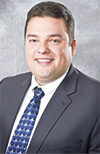Body condition scoring (BCS) is a relative measurement of the amount of fat tissue that cows store, which is also correlated to their energy reserve. The industry uses a 5-point scale (with quarter-point increments) to determine the body condition of dairy cows. By evaluating BCS changes, we can identify possible nutritional deficiencies, health issues and, by extension, potential impacts on milk production and reproductive performance.
Researchers have been working with this measurement and finding strong correlations between BCS changes and health, production and reproduction efficiency.
After calving, cows change from a low- to a high-energy diet and from a state of being pregnant, non-lactating animals to non-pregnant, lactating animals. Most cows enter a phase called negative energy balance. During this phase, they spend more energy to keep their daily activities than they are able to consume in their diet.
Due to this stage of negative energy balance, cows tend to lose body condition. There are solid correlations with changes in BCS during this timeframe with events that occur throughout the whole lactation – and often action needs to be taken prior to calving to prevent challenges after calving.
BCS research
Observations (unpublished) from almost 9,000 cows from two California dairies conducted by Dr. Luis Mendonça, Kansas State University assistant professor and extension specialist, and Dr. Ricardo Chebel, University of Florida Department of Large Animal Clinical Sciences associate professor, demonstrated that more than 40 percent of cows lost BCS during the dry period.
Furthermore, those cows with a BCS change during the dry period (moderate loss of 0.25 to 0.5 or excessive loss of 0.75 or greater) were more susceptible to present health issues after calving (stillbirth, retention of fetal membranes and metritis). These cows were also more likely to be culled from the herd before 60 days in milk (DIM), compared with cows that had no change in BCS during the dry period.
But more important was the finding that the cows increased their chance to lose BCS if they entered the dry period with a score of 3.75 or more.
These data indicate cows that enter the dry period with a BCS between 3 and 3.25 reduce their chances to lose BCS during the dry period, therefore preventing this negative effect on health parameters after calving.
More evidence
Dr. José Santos, University of Florida animal science professor, and his team conducted a series of experiments to show how the incidence of diseases postpartum affects fertility of lactating dairy cows.
Results demonstrated cows that had at least one health disorder after calving (physical or metabolic) experienced delayed resumption of cyclicity, had a lower conception rate for first service and had increased pregnancy loss.
When these two points of relevant information are tied together, you can start to understand the importance of avoiding BCS change during the dry period to prevent serious issues post-calving.
New research presented at the 2015 American Dairy Science Association Annual Meeting demonstrated the association between BCS change and reproductive performance of lactating Holstein cows.
This analysis included data from 5,260 cows on nine commercial dairies across the U.S. BCS data was taken at 7(±3) DIM and at 35(±5) DIM.
Results show cows with BCS more than 3.25 at 7 DIM had a greater chance to lose more than 1 BCS unit from day seven to 35 DIM. This change was associated with delayed resumption of cyclicity by 50 DIM, and it compromised reproductive performance.
Two more studies
Two experiments conducted by Dr. Paul Fricke, professor of dairy science and extension dairy reproduction specialist, and Dr. Milo Wiltbank, professor of dairy physiology, at the University of Wisconsin – Madison further demonstrate an association between fertility and BCS near A.I.
The first experiment featured 1,103 cows; the second experiment included 1,887 cows. The studies examined fertility and early lactation changes in BCS.
To minimize the negative effect of delayed resumption of cyclicity, cows received a protocol for a first timed-A.I. (double Ovsynch), and the BCS measurements were focused on the first three weeks of lactation.
In the first experiment, cows were divided by BCS category: 2.5 or less, 2.75, 3 and 3.25 or greater.
Based on an analysis that included all BCS categories, conception rate tended to differ by BCS, with reduced conception rates for cows with BCS of 2.5 or less (40 percent), and intermediate rates for cows with BCS of 2.75 (48 percent) and BCS of 3 (48 percent). Conception rates were greatest for cows with BCS of 3.25 or greater (52 percent).
In addition, when cows were categorized as having high (2.75 or greater) or low (2.5 or lower) BCS near A.I., conception rates differed between BCS categories. Conception rates were greater (P = 0.03) for cows with high BCS, compared with cows with low BCS (49 versus 40 percent, respectively).
In the second experiment, around 42 percent of cows lost BCS, 36 percent maintained BCS and 22 percent gained BCS between calving and 21 DIM.
Surprisingly, the conception rate for first service for cows that lost BCS was 25 percent. Those that maintained BCS had a conception rate of 38 percent, and cows that gained BCS had a conception rate of nearly 84 percent. Even though the results matched expectations, researchers concluded that this experiment needs to be replicated on other dairies to widely apply this concept to the industry.
In conclusion, it is important to find the right balance and the ideal BCS for cows in different stages of their lactation. Therefore, there doesn’t seem to be one magic BCS number for cows – that number changes depending on where a cow is in her lactation.
It is as important, or even more so, to avoid dramatic changes in BCS during the dry and early lactation periods to ensure a smooth transition period and maximize production and reproductive efficiency. PD

-
Glaucio Lopes
- Large Herd Manager and Repro Specialist
- SCR Dairy Inc.
- Email Glaucio Lopes






